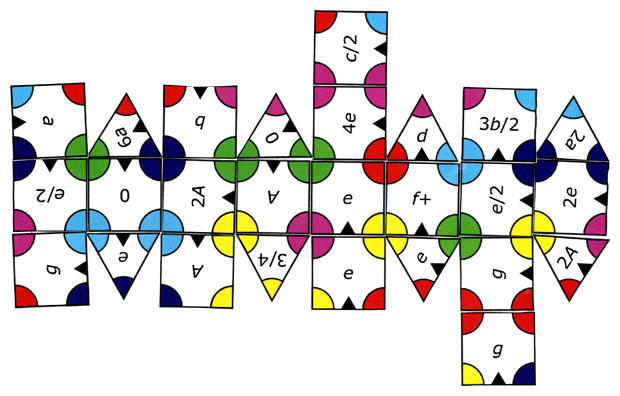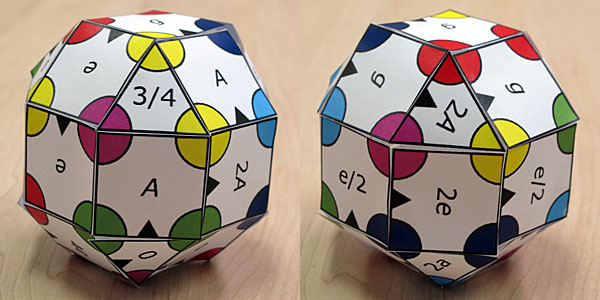
CISRA Puzzle Competition 2011 - Solutions
2A. Squares and Triangles
The puzzle presents 18 squares and 8 triangles; each piece has brightly coloured corners, a few characters written on it, and in most cases a small black triangle on one edge.
The characters seem (in most cases) to be a letter from "a" to "g" (or "A"), in many cases multiplied by some fraction. There are some exceptions: "f+", "0", "3/4". The fact that only letters in that range are used suggests a possible connection to musical notes, and the multipliers used could well indicate note lengths. Viewed in this light, the exceptions also make sense: "f+" could indicate f-sharp, "0" a rest, and the letterless "3/4" might be a time signature. "A" might represent a note an octave higher than "a".
Of course, this is all well as a theory, but without a way to order the notes the chance to find a solution is limited. So we must find some way to arrange the squares and triangles.
The coloured corners are provocative. It seems natural to try and match them – to place two pieces adjoining along an edge so that on each corner, the colours from each piece are the same. A little experimentation shows that every edge has a match in this way, although some edges do have more than one candidate.
Experimentation shows that not all of the pieces can be matched up - if you stick to two dimensions. This may lead to the realisation that every edge can actually be matched up simultaneously, provided we move to the third dimension. A bit of work with scissors and tape can enable the construction of a (small) rhombicuboctahedron out of the pieces, in such a way that every vertex is coloured with a single colour. Here is the net of the resulting solid, laid out flat:

The assembled solid looks like this (shown from two different sides):

Once this assembly has been performed, the small black triangles can be seen to define a path around the object, starting with the triangle labelled "2a" and ending in one of the squares labelled with "e". When tracing this path, note that the triangles indicate the direction of entry to a face, not a direction of exit.
The path defined leads to the following sequence of letters:
2a, a, e/2, 2e, e/2, 3b/2, c/2, b, 6a, 0, e, g, 2A, g, e, f+, d, 4e, 0, A, 2A, A, g, e, e
One face is not visited in the path - the one labelled with "3/4". This may confirm the idea that this represents a time signature rather than a musical note.
When the corresponding notes are read off and played, a familiar ear will identify the tune as the traditional ballad SCARBOROUGH FAIR, which is the answer.
Puzzle design notes (no pun intended):
I wanted to make something that would visually recall the horror of my puzzle "5D: 3d" from last year, but not be anywhere near as difficult to solve. Naturally I gravitated towards assembling three-dimensional solids from coloured pieces. I settled on the shape early, then had to find a mechanic to fit it. I decided that each face could be made to represent a musical note and a path traced along the faces could make a tune.
I built several of the solids and started tracing paths, only giving up when I realised it was impossible to reach every face of the rhombicuboctahedron in a continuous path (and when my hands were stained with nk of three different colours) - there would always be one triangle left over. Then I hit on the idea of using the unvisited triangle to give the time signature. I know that time signatures are never written in music as fractions (with a stroke separating the two numbers), but I wanted to maintain the illusion that the puzzle might be an algebra problem and not simply give away the fact that the letters represented musical notes.
From there, the major job was to colour the vertices in such a way that it would be possible, but not trivial, to match them up to form the solid. I began with four colours, but quickly realised that repetition led to unresolvable ambiguities in the edge matching. So I went up to five colours, and ran into a similar problem. It might have been made to work with five colours, but I ran out of patience with rearranging the colouring after numerous test solves in which I hit brick walls of ambiguity. Six colours took a bit more rearranging, but I finally got it to work.
The one remaining problem that bugged me was that Scarborough Fair (I settled on the tune fairly early - deciding a timeless ballad would be a fairer test of musical recognition than some more modern and ephemeral tune) has tied notes that cross bar lines (the "6a" and "4e", held for 6 beats and 4 beats respectively). I knew that these are represented in musical notation as separate notes in different bars, and then tied, rather than single long notes that extend across bars. But I didn't want to separate the "6a" into "3a" and "3a", because that would give the impression of being two notes rather than a single long one. So I defied musical convention (again) and just went with a single note representation.